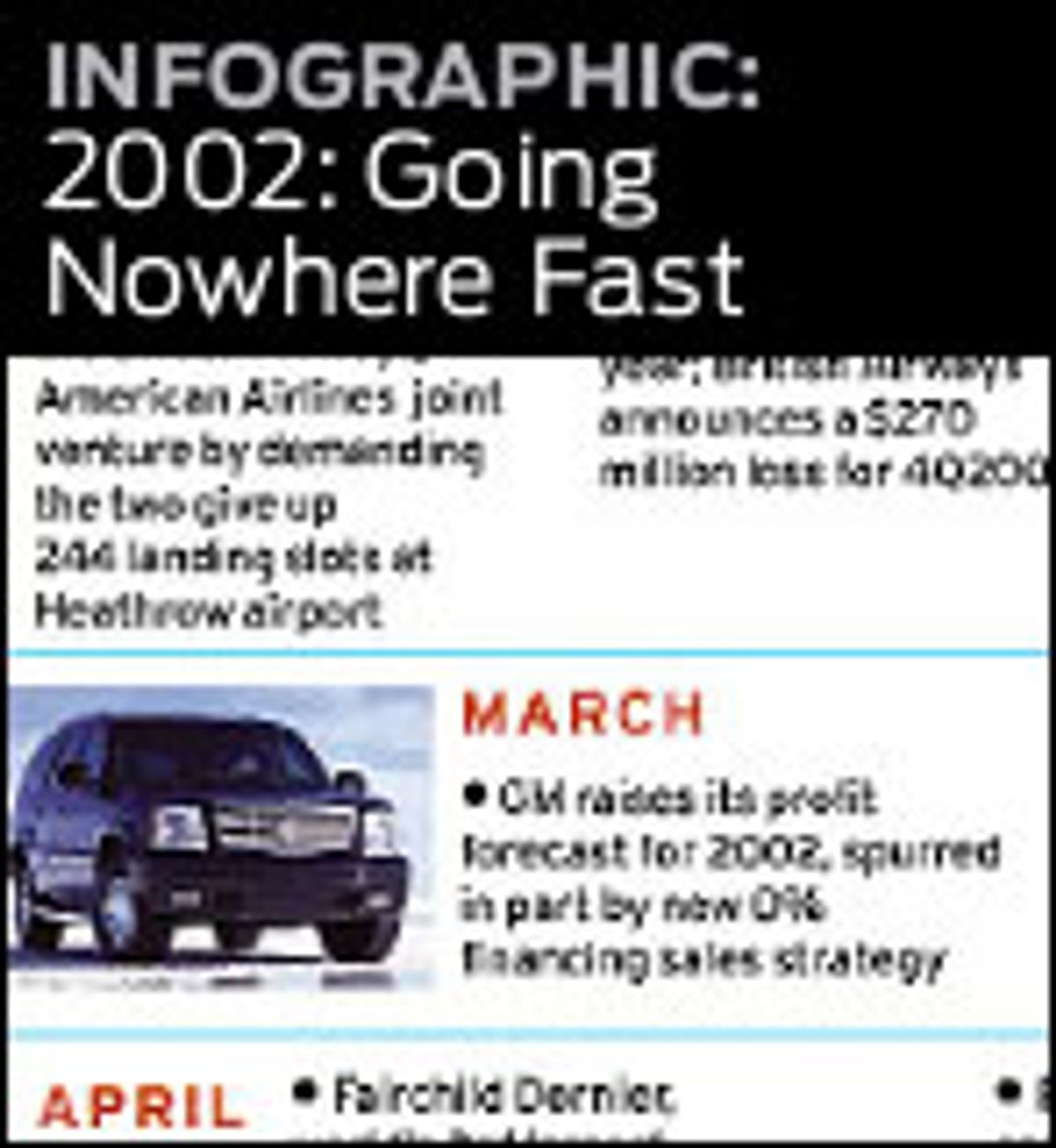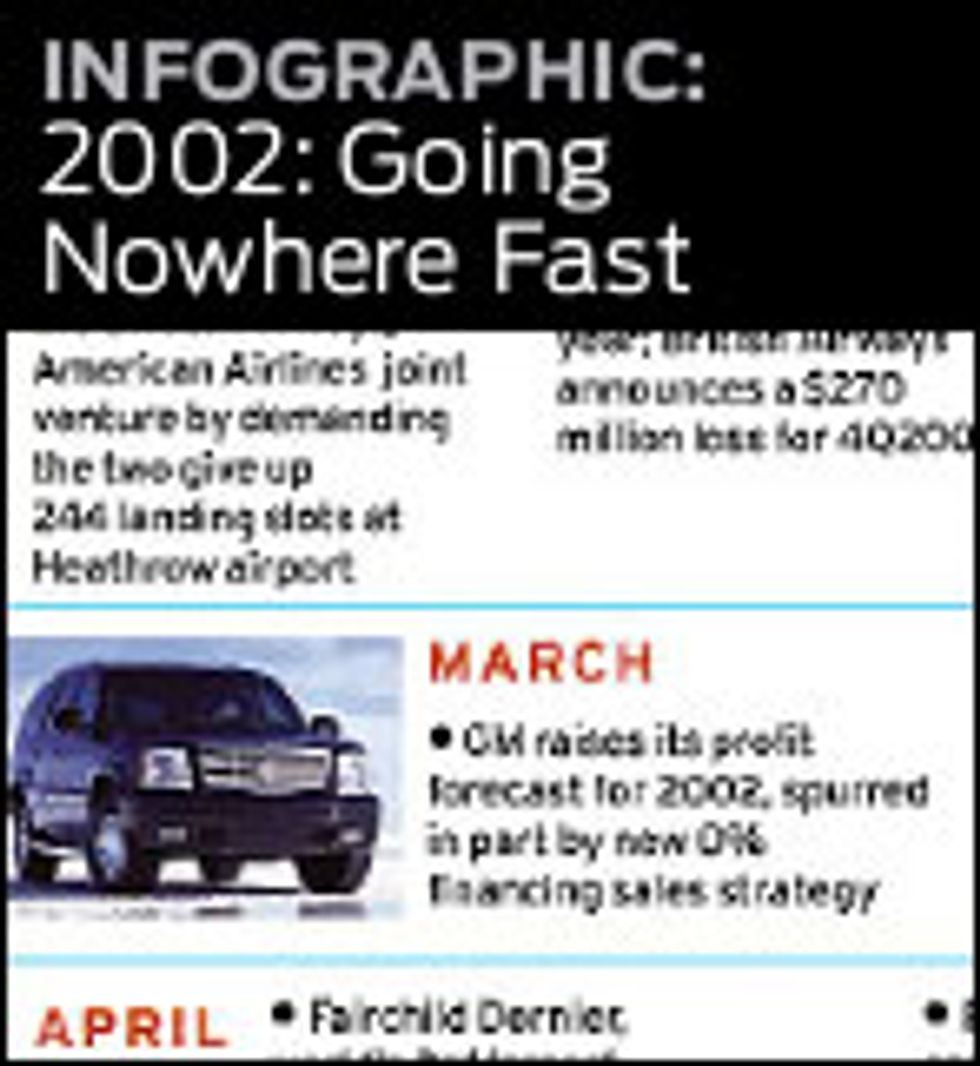Running off the Rails
High-speed rail works well in Europe and Japan, so why can't the United States get it right?

This is part of IEEE Spectrum's special report: What's Wrong—What's Next: 2003 Technology Forecast & Review.
North America is facing a transportation crisis. Highways in urban areas are becoming more congested every year. Airlines are teetering on the brink of bankruptcy, clinging to bewildering fare structures and otherwise alienating customers. Fuels still come from oil imported from regions of the world that are potentially unstable. It's time for North Americans to get serious about high-speed rail.
Europe and Japan lead in making high-speed rail the centerpiece of their transportation infrastructures. Over a million people shuttle daily in sleek Shinkansens, gleaming TGVs (Trains à Grand Vitesse), and swift InterCity Express (ICE) trains. Impressed by these trains' record speeds, dependability, and comfort, South Korea and Taiwan are now building high-speed lines, and China is planning major new lines of its own. In the densely populated, heavily trafficked Northeastern corridor of the United States, however, the very place that could and should be one of its greatest success stories of all, high-speed rail remains a disappointment.
Slow and faulty, but well-received
The inadequacy of U.S. interurban rail was thrown into sharp relief last August when structural and mechanical problems forced a temporary suspension of its premier service—Amtrak's Acela Express trains. They had only been in operation for 20 months and had sustained, on average, speeds less than half of their European and Japanese counterparts.
Even so, Acela is well-received, suggesting that popular acceptance is not the bar to high-speed rail. Acela attracted more passengers than the two competing air shuttles, which link New York City with Washington, D.C., and Boston (56 percent of all travelers versus 44 percent for the Delta and US Airways shuttles, combined). Although the picture may be somewhat skewed by the lingering nervousness over the possibility of more terrorist attacks, they indicate strong support for a railway option in the Northeast.
The scheduled Acela Express trip time from New York City to Boston is three hours and 20 minutes. The air shuttle schedule for the same trip is one hour and 15 minutes. Even adding 45 minutes of airport waiting time, typical for passengers on shuttle flights, doesn't make rail a significantly better option. But add the comfort of train travel coupled with a 2.5-hour trip—Acela's original objective—and rail becomes very competitive with air shuttles.
The technical side of Acela has been troubled from the start. Delivery of the first of 18 Acela Express trainsets from Bombardier Inc. (Montreal) to Amtrak was delayed over a year amid accusations from the manufacturer that Amtrak had made costly, late changes to the design details and specifications. One result is that the train ended up being 10 cm too wide. This restricts the tilt capability in the Northeast corridor, imposing speed constraints on curved track, and longer running times. The hoped-for 2.5-hour trip from Boston to New York remains an elusive goal.
While there were some unresolved equipment shortcomings that did not jeopardize safety, Amtrak accelerated delivery. A major fault was revealed during a routine maintenance check on 12 August 2002. A bracket holding a yaw damper on an Acela locomotive had fractured. Each locomotive has eight such brackets, two at each corner, to reduce the oscillatory motion of the locomotive body around a vertical axis through its center of gravity. Checks on other trainsets revealed similar (although not as severe) cracking—clearly this component was fatigue stressed beyond its design limit.
Unsung Hero
DAVID GUNN inherited a minefield when he stepped in as CEO of Amtrak in May 2002. But he acted swiftly and decisively when faced with his first test—the stress cracks that put Acela out of service. Next up, the budget battle
Under Fire
The embattled CEO of United Airlines, GLENN F. TILTON, filed the largest bankruptcy in aviation history on 9 December, covering US $22.8 billion in assets
Wish List
PRECISE TRACK ALIGNMENT for the U.S. Northeast corridor, which could make all the difference in achieving truly high speeds, but can only come with new, purpose-built tracks on dedicated rights-of-way, not on retrofit rail lines shared by other trains
Withdrawn for fixing
Consequently, the entire Acela Express fleet was withdrawn from service on 15 August and replaced by the Metroliner equipment that preceded it. Welding and grinding of the problematic brackets was permitted as a temporary fix pending the design, fabrication, and installation of stronger ones.
The Acela trains were reintroduced to service on 19 August, along with a rigorous program of maintenance checks involving the use of dyes to detect microcracking after each run. Related problems were detected two days later, when checks revealed hairline cracks in the side sills running the length of each locomotive. These cracks were located adjacent to the yaw damper brackets, and were clearly another manifestation of the same problem.
Engineers at Bombardier and Amtrak were mobilized to repair the side sills and brackets by welding, grinding, and buffing. Carefully inspected after each run, the fleet has since operated reliably pending the installation of new, strengthened damper brackets, which fix the ends of the yaw dampers between the locomotive and its truck frame.
In addition to this major fault, about 200 comparatively minor defects in the Acela Express trains have been identified, including sticking toilet doors and pantograph skipping. (The pantograph makes contact with the overhead electric lines; momentary loss of contact is known as skipping.) A worrying truck hunting problem persists, and wheel wear is somewhat higher than anticipated. (Truck hunting is a low-frequency yawing oscillation of the wheel sets rolling on the rails.)
At the forefront
But why all these problems when high-speed rail has been operating successfully in Europe and Japan for decades? Introduced at 210 km/h in 1964 between Tokyo and Osaka, the Shinkansen has been progressively extended and upgraded to offer up to 300-km/h service on 2047 km of purpose-built line. The TGV in France, the X2000 in Sweden, the ICE in Germany, and the AVE (Alta Velocidad) in Spain now offer fast, reliable intercity service over a network of rail lines at speeds up to 300 km/h across Europe. And serious consideration is being given to raising operating speeds towards 350 km/h over longer intercity routes.
Other countries in the Asia Pacific region have recognized the socioeconomic value and potential of high-speed rail. The infrastructure for 300-km/h service is in an advanced state of development in South Korea for a 430-km line from Seoul to Pusan, and in Taiwan for a 345-km line between Taipei and Kaohsiung. In China, the first implementation will be the 1300-km flagship route from Beijing to Shanghai, but planning is already under way for a 8135-km network of high-speed lines linking major regional cities from Harbin in the north, to Xian in the west, and Hong Kong in the south.
ALSTHOM SA is helping the Korean High Speed Rail Authority build trains in South Korea based on the French company's TGV design. The trains will run on a new, dedicated high-speed route between Seoul and Pusan this year. Alsthom is also exporting the technology to Taiwan
Tech Watch
THE SHINKANSEN Japanese bullet trains run at 300 km/h, while research continues to improve the service and its underlying technology
At estimated speeds of up to 500 km/h, magnetically levitated (MAGLEV) trains could affect high-speed rail programs in the United States and Asia. All eyes will be on China as it starts up a 30-km link this month from Shanghai to its airport
Trouble Signs
THE NATIONAL RAIL CO. popularly known as Amtrak is woefully short on profits while the U.S. Congress wants a self-sustaining operation. But is that possible?
Restricted tilt capability slows ACELA on the curved sections of track, making a 2.5-hour trip from Boston to New York City a seemingly impossible dream
Piecemeal design doesn't work
So why the problems in the U.S. Northeast corridor? High-speed rail should be designed and built as a system, with a dedicated right-of-way that has the alignment and trackage with the limited curvature and superelevation (raised outer curves enhance both safety and passenger comfort) demanded by high-speed operation. And it needs compatible rolling stock, the generic industry term for locomotives and train cars.
The luxury of a new dedicated alignment was just not possible in the Northeast corridor; the existing tracks had to be used and shared with less speedy trains. Though progressively improved over the past 30 years to take out the sharpest curves, renovate bridge structures, and add electrification, the route through densely populated regions still imposes speed restrictions on high-speed trains. While capable of 240 km/h, the scheduled average speed for Acela Express service from New York City to Washington is only 138 km/h, while the Boston-New York City run averages a mere 100 km/h.
For comparison purposes, SNCF in France provides a glimpse of the art-of-the-possible. Prior to the opening of its Méditerranée service, it demonstrated that a standard TGV trainset could cover the 1000 km from Calais to Marseille at the average speed of 317 km/h, reaching a top speed of 366 km/h.
The Amtrak contract for trainsets was awarded to Bombardier of North America in partnership with the French company Alsthom SA to introduce elements of TGV technology into North America. The resulting problems were multidimensional, and it is tough to pin the blame on one party. There were communication and coordination difficulties between two engineering teams that had not previously worked together. At the same time, Amtrak management, having been lured by cheap financing for a technologically unproven trainset, did not maintain a sufficiently tight grip on the project. Accusations back and forth have resulted in Amtrak withholding US $51 million in milestone payments, while Bombardier is seeking US $200 million in a lawsuit as compensation for cost overruns incurred by Amtrak's design changes.
When the dust settles and the remaining problems are fixed, the Northeast corridor should have a reasonably reliable train service that achieves speeds up to 240 km/h. Indeed, its premium Acela service is vitally important to Amtrak as it attempts to reduce its seemingly perpetual requests for federal subsidies [see "Running up the Bills"].
In retrospect, some problems were to be expected, considering that an unproven advanced-technology train was being introduced on an existing, if upgraded, infrastructure. Despite these teething troubles, Acela Express is a success. It has already carried over four million passengers and is more popular than the corridor air shuttles. Trip times can be reduced further over the next 5-10 years with more improvements to the alignment and infrastructure. Amtrak's goal is to reduce the Boston-New York City trip to 2 hours 30 minutes and New York City-Washington to 2 hours 15 minutes. Certainly many $100 millions of additional investment are needed to get the trip down to Amtrak targets. There are many local improvements to be done, each of which could trim seconds or even minutes off trip time.
The Northeast corridor is the proving ground for high-speed rail in North America, from both technical and marketing perspectives. It carries most of the interurban rail passengers in the United States. High-speed rail is an indispensable mode for intercity travel in Europe and Japan, and it is coming in South Korea, Taiwan, and China. For the sake of sustainable mobility in an environmentally acceptable manner, high-speed rail must be the way forward in North America, not only in the northeast United States, but also in the San Francisco-Los Angeles-San Diego, Tampa-Orlando-Miami, and Quebec-Montreal-Ottawa-Toronto-Windsor corridors. Its time is coming in North America.
To Probe Further
For general news about railroads, visit https://www.railnews.net
For rail technology news, visit https://www.railway-technology.com/
